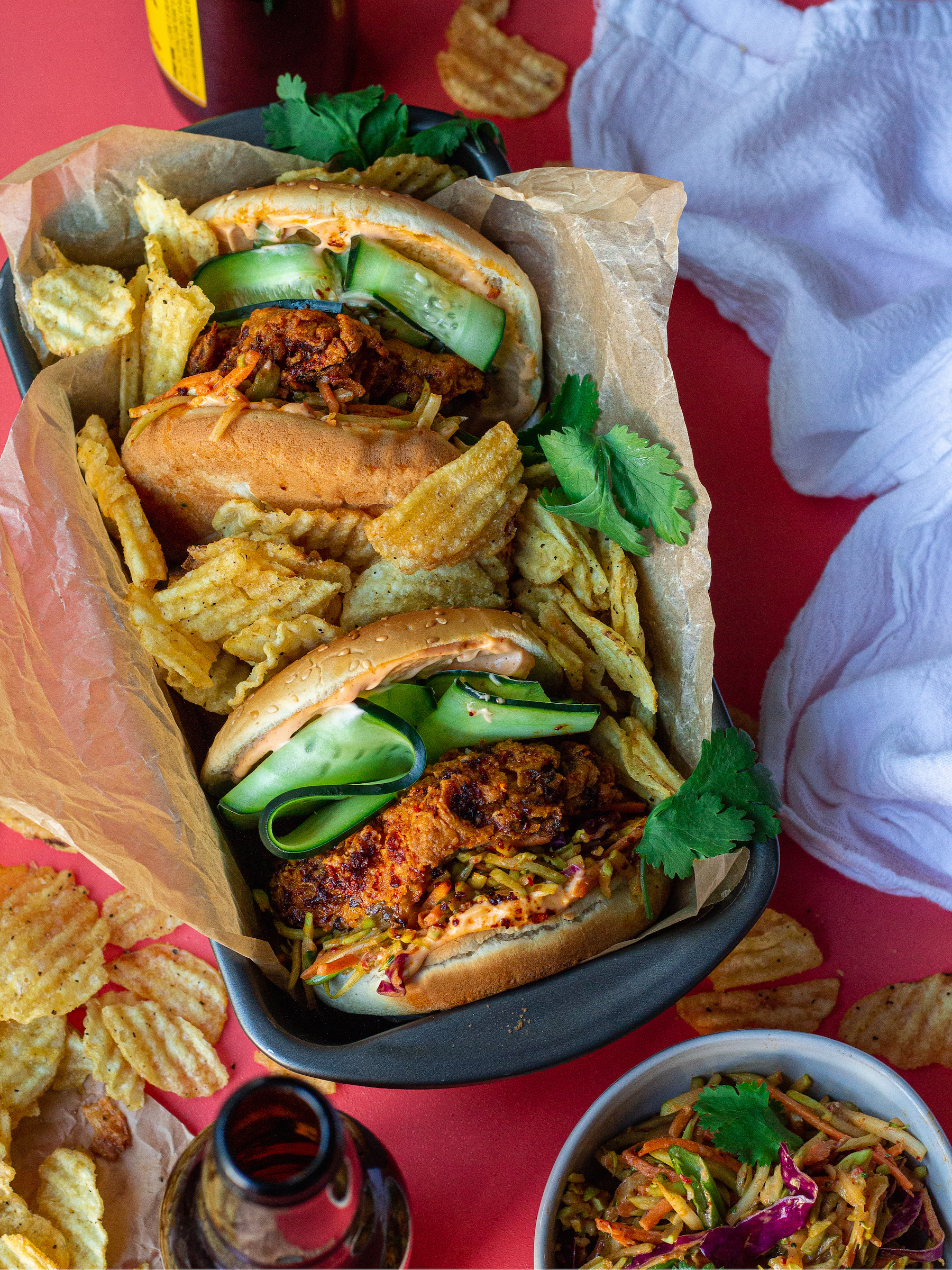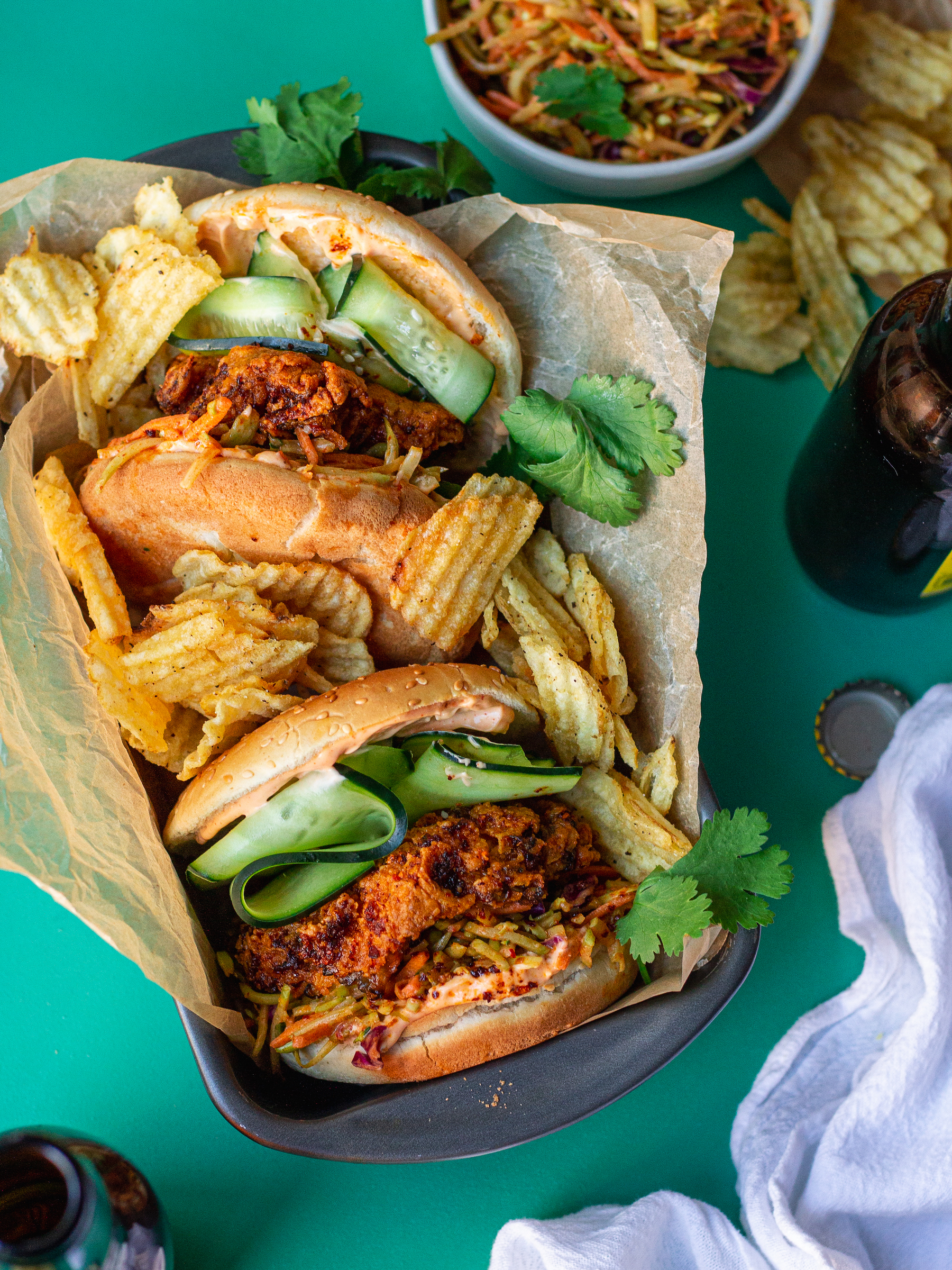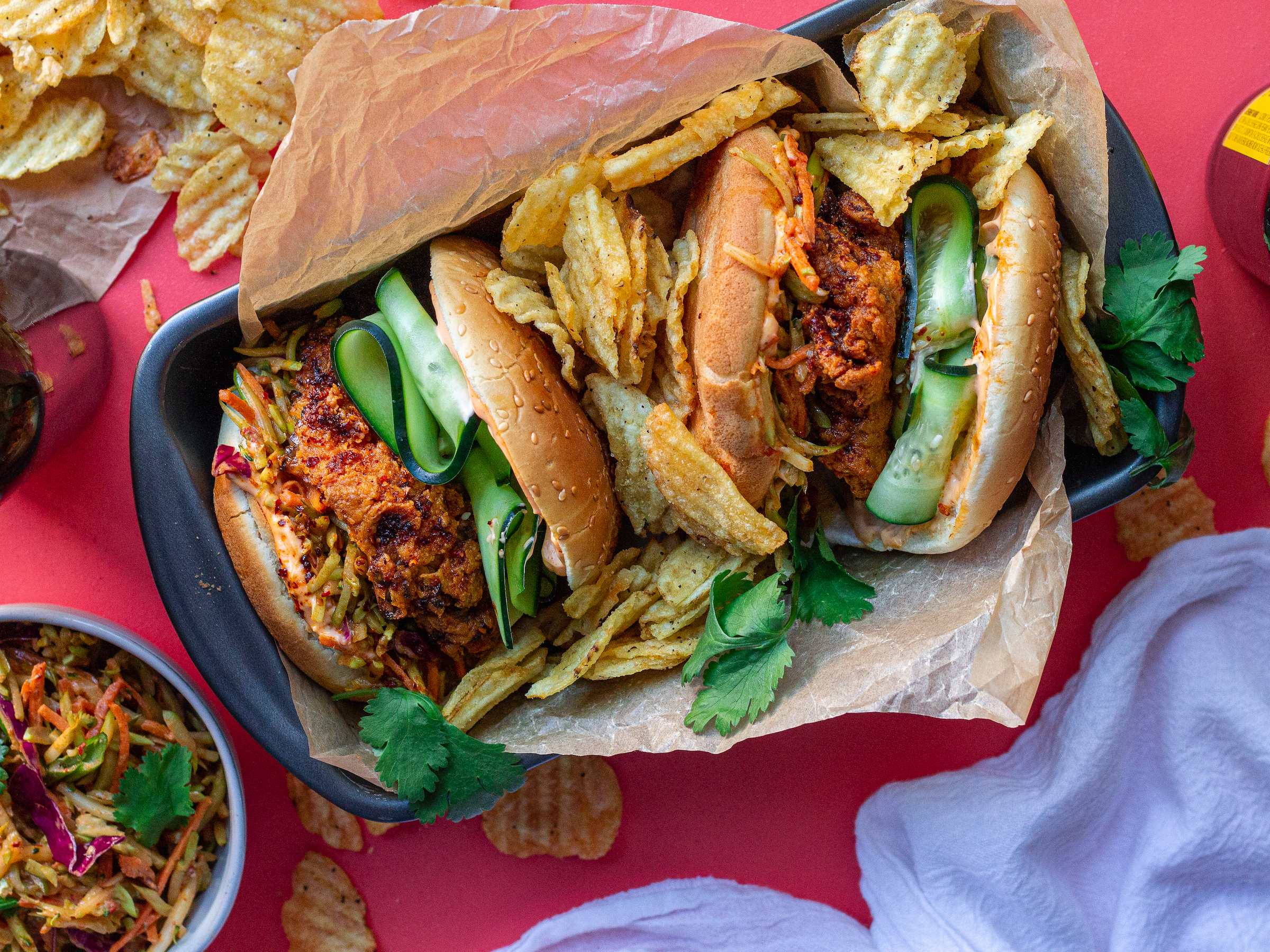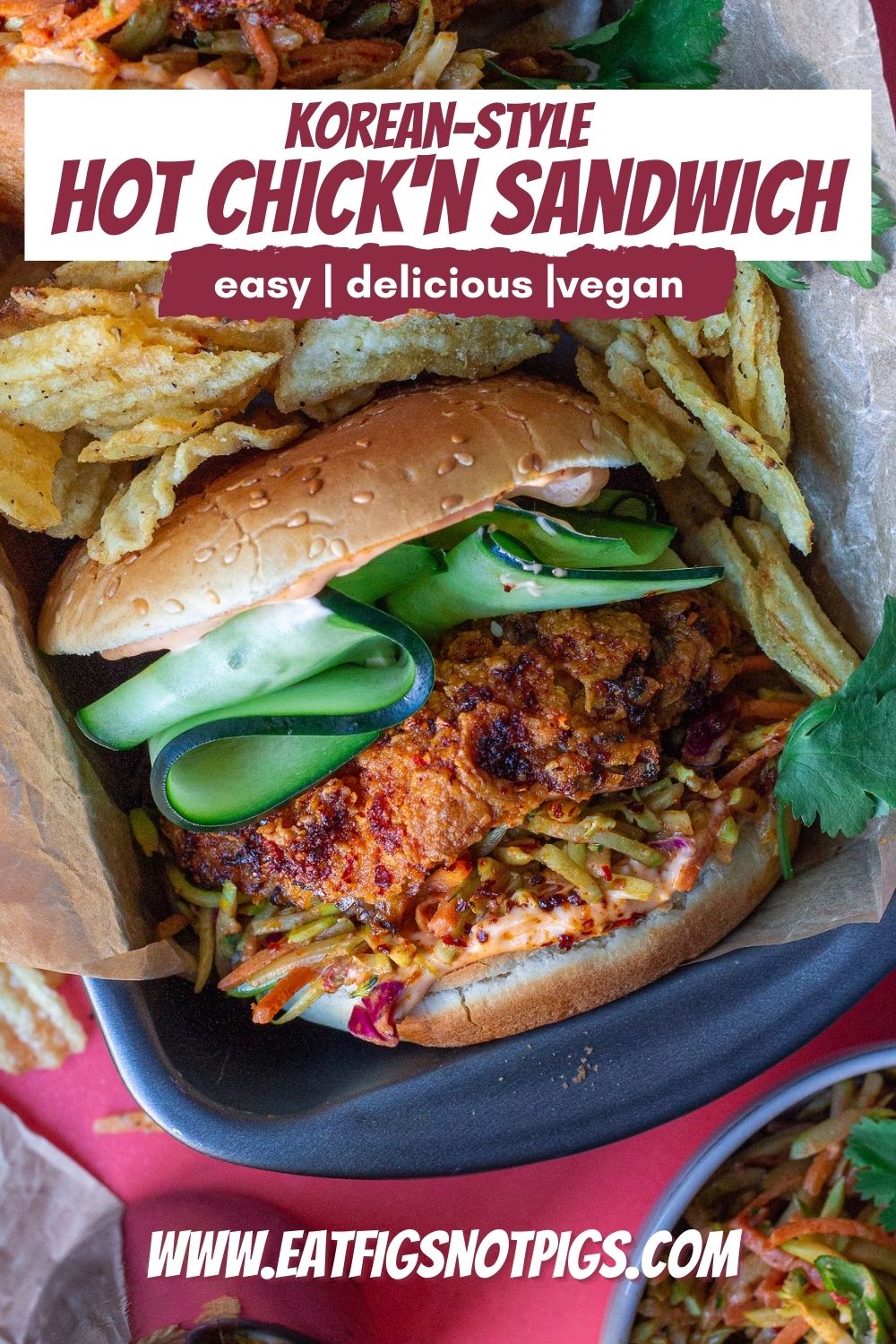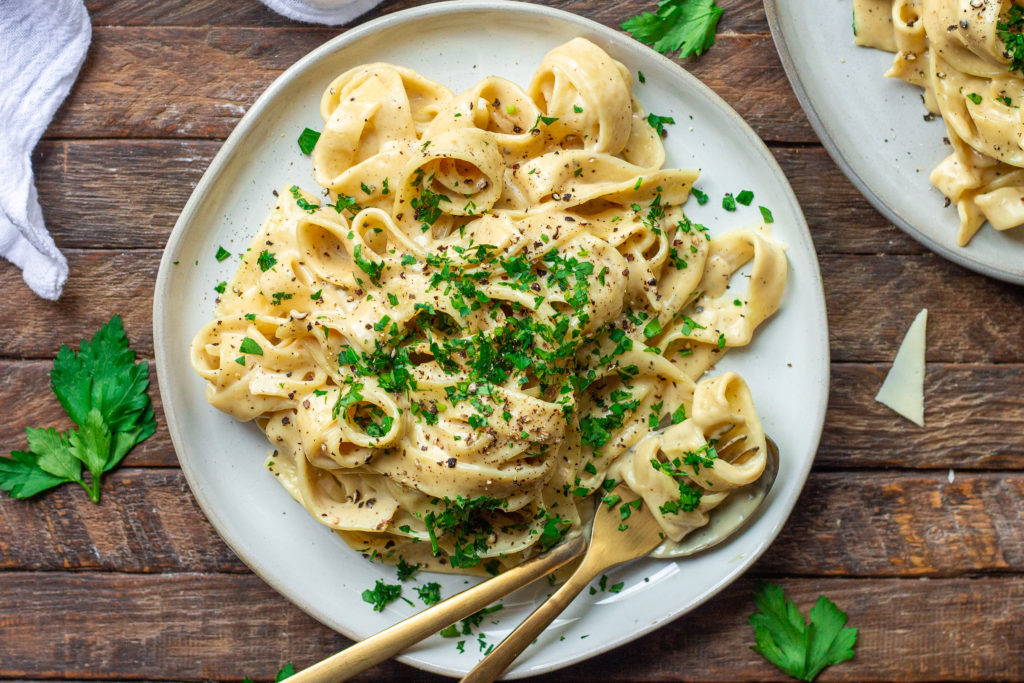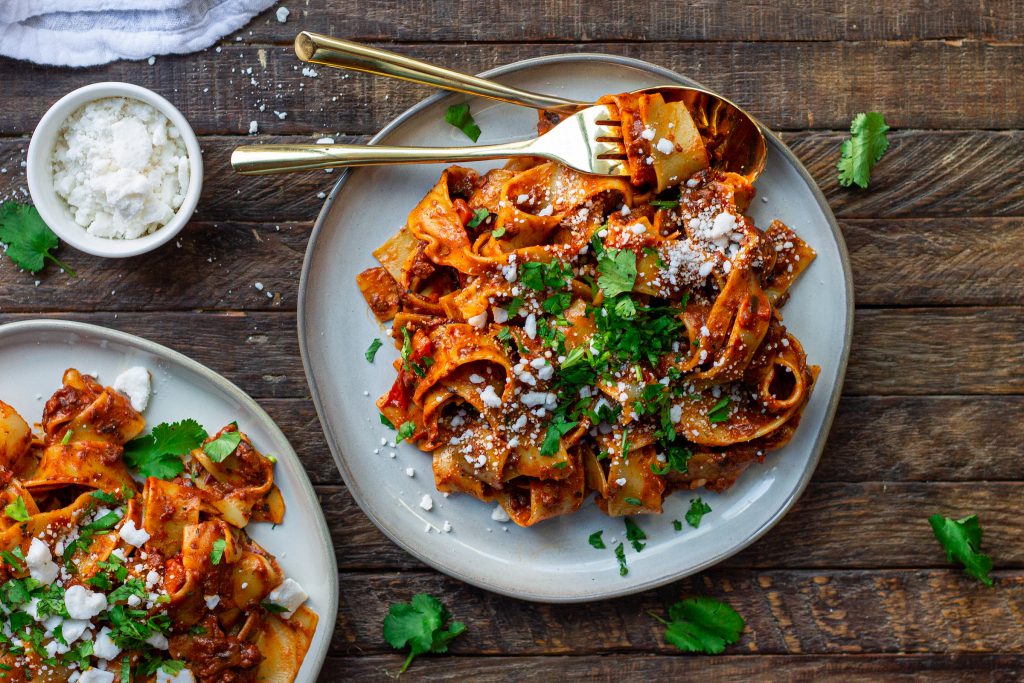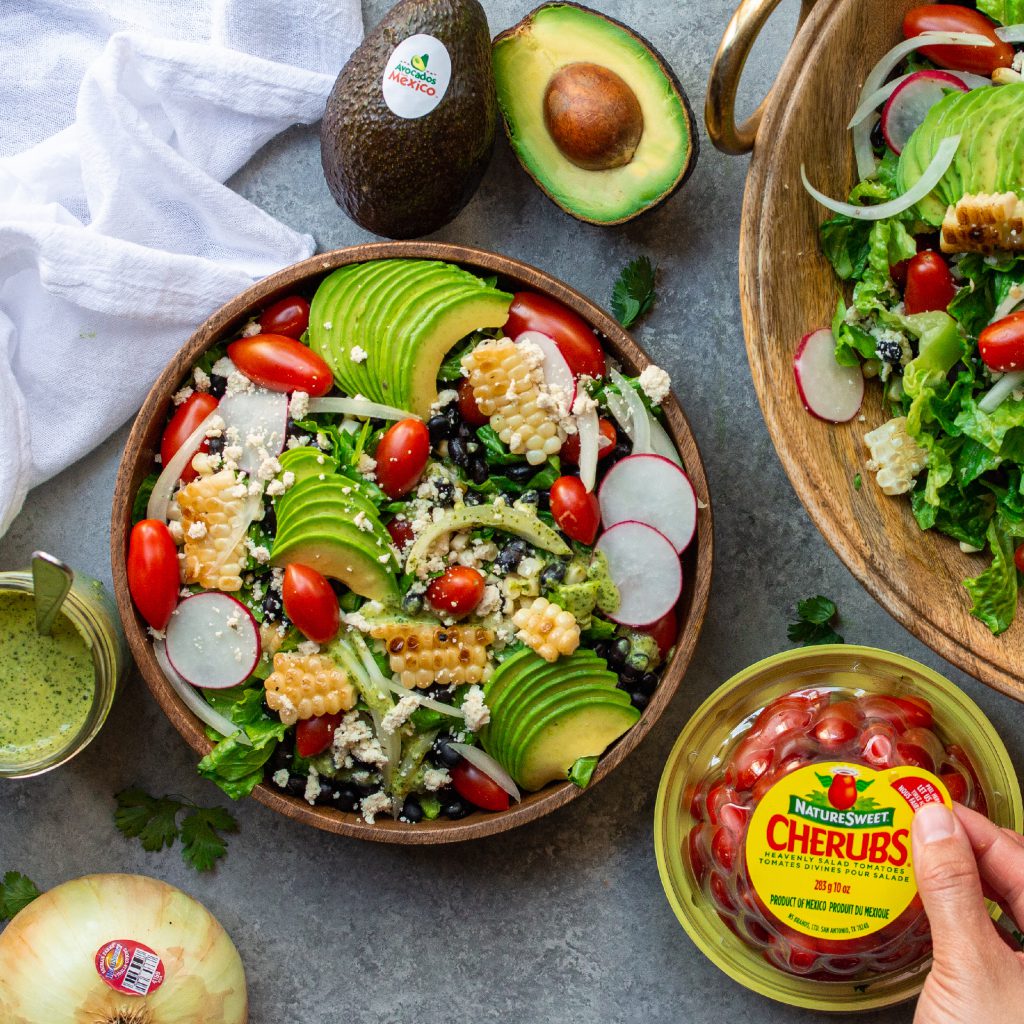March 16, 2022
Korean-Style Hot Chick’n Sandwich
Korean-Style Hot Chick’n Sandwiches – inspired by the one and only Nashville Hot Chicken Sandwiches, but with a Korean-inspired twist. Meaty mushrooms are fried to crispy-on-the-outside, juicy-on-the-inside golden perfection, then doused in delicious gochugaru chili oil and sandwiched in between a soft bun with tangy gochujang slaw! If you’re a fan of hot ‘n spicy sandwiches, you’re going to love this one!
Korean-Style Hot Chick’n Sandwich
If you like crispy, juicy, slightly spicy sandwiches (that are undoubtedly messy, but totally worth it), just wait until you sink your teeth into this Korean-Style Hot Chick’n Sandwich! It’s crispy on the outside, juicy on the inside, and packs just the right amount of heat!
Grab a drink and let’s get to cookin’ the best Korean-Style Hot Chick’n Sandwiches!!!
but first, Nashville hot chicken.
First, let’s learn about the OG. After all, I got all my inspiration for this recipe from the one and only Nashville Hot Chicken, and my sandwich wouldn’t exist without it.
Hot chicken, AKA Nashville Hot Chicken is a type of fried chicken that is a local specialty of Nashville, Tennessee, in the United States. In its typical preparation, it is a portion of breast, thigh, or wing that has been marinated, floured, fried, and finally covered in a paste or thick sauce that has been spiced with cayenne pepper. This certain method of preparation originates in the Southern United States. A richly pigmented seasoning paste gives the fried chicken its reddish hue. Spice blends, preparation methods, and heat intensity vary from recipe to recipe or depending on the chef.
Recounted testimonies imply that hot chicken has been prepared and served in Nashville, specifically the African-American communities, as early as the 1930’s. This article, How Nashville Chicken Really Started, by Rachel L. Martin is a great read on the history of Nashville’s Hot Chicken origins.
It is generally accepted that the originator of hot chicken is the family of Andre Prince Jeffries, owner of Prince’s Hot Chicken Shack. Jeffries says the development of hot chicken was an accident. Her great-uncle Thornton was purportedly a womanizer, and after a particularly late night out, he came home in the early hours of the morning expecting breakfast to be made by his girlfriend. Fed up with his two-timing ways, she decided to cook him a fried chicken breakfast with extra pepper (and anything else she could find that she thought was too spicy to bear) as revenge. Instead, Thornton decided he liked it so much that, by the mid-1930s, he and his brothers had created their own recipe and opened the BBQ Chicken Shack café. What started as a revenge meal has now turned into a phenomenon that taken over the United States!
The article written by Rachel L. Martin dives much deeper into its history, and I definitely recommend giving it a read!
ingredients for Korean-Style Hot Chick’n Sandwiches (and substitutions
This recipe calls for a handful of fridge and pantry staples that I always have on hand! Don’t be deterred if some of these ingredients are new to you – they’re wonderful in a variety of dishes (like these: Cheesy Gochujang Udon Noodles, Pan Seared Tofu with Gochugaru Chili Oil, and Cheesy Gochujang Skillet Fried Rice), and will last months! Here’s what you’ll need to make my Korean-Style Hot Chick’n Sandwiches:
for the slaw:
- Gochujang: gochujang is a fermented korean chili paste. It’s savory, with hints of spice and sweetness. I typically find gochujang at my local Asian Market and specialty supermarkets such as Whole Foods and Walmart.
- Vegan mayonnaise: There are so many brands that make plant-based mayo these days! I find it pretty accessible and at most grocery stores.
- Coconut sugar: I like using coconut sugar as it’s naturally vegan. You can substitute this for vegan-friendly granulated sugar, brown sugar, or maple syrup.
- Low-sodium soy sauce: you can substitute for regular soy sauce, but make sure to start with 1 teaspoon, then taste and adjust as needed.
- Rice wine vinegar: you can find rice wine vinegar at most grocery stores and asian markets. You can sub it for equal portions seasoned rice vinegar, white wine vinegar, or apple cider vinegar.
- Bagged broccoli slaw mix: you’re certainly welcome to make your own slaw mix, but I’m lazy ???? I personally love the broccoli slaw mix, but if you can’t find it, you can sub it our for regular coleslaw mix.
- Green onions: chives, red onion, or white onion will work in its place!
for the Korean-style hot chick’n:
- Non-dairy milk: make sure it’s unsweetened and unflavored. The last thing you want is a vanilla flavored sandwich!
- Vegan eggs: Vegan eggs are used primarily as a binding agent in place of regular eggs – not as an egg substitute for egg-based dishes such as omelets or quiches. I use the packaged egg replacer from Bob’s Red Mill for convenience. You can typically find it at most health food stores and some bigger chains such as Target and Walmart. Simply follow the instructions on the back of the package for preparing the number of vegan eggs needed for the recipe. If you’re unable to find vegan egg replacer, you can most definitely make a flax or chia egg. To make a chia or flax egg, mix 1 tablespoon of chia seeds or ground flaxseed meal with 2 ½ tablespoons of water (this is equivalent to 1 “egg”). Set aside to coagulate for about 5 minutes before adding to the liquid.
- Flour: I haven’t tested this recipe with any flour besides all-purpose, so I’m not sire of another type will work as well.
- Vegetable oil, for frying: you cannot, I repeat … you cannot, air fry or bake these. Not because I don’t want you to (even though I don’t), but because wet batters don’t work for air-fryers or ovens. If you try to air fry these, they will simply disintegrate into a lumpy, flour-y, mess.
- Maitake (AKA Hen of the Woods) mushrooms: maitake mushrooms, also known as hen of the woods, is a polypore mushroom that grows at the base of trees, particularly old growth oaks or maples. It is typically found in late summer to early autumn. The body is a cluster consisting of multiple grayish-brown caps which are often curled or spoon-shaped. You can typically find them at specialty asian markets, health-food stores such as, or local farmer’s markets. If you’re unable to access Maitake mushrooms, you can sub out for oyster mushrooms
- Gochugaru flakes: a chili powder traditionally made from sun-dried Korean red chili peppers known as taeyang-cho, with spicier varieties using Cheongyang peppers. I can find this at my local Asian Market, and some supermarkets such as Whole Foods and Sprouts. If you can’t find gochugaru, you can sub it with red chili powder.
- Chili Oil seasonings: maple syrup, salt, garlic powder, ground ginger, cayenne pepper, white pepper
for the sandwiches:
- Buns
- Gochujang mayonnaise: since I already had vegan mayo and gochujang, I decided to whip up a sauce! Totally optional, but definitely worth it.
- Thinly sliced cucumber: they add the perfect crunch!
how to make Korean-Style Hot Chick’n Sandwiches
Crispy chick’n fried shrooms, gochujang slaw, and chili oil sauce are truly a match made in heaven. What’s even more heavenly is that these sandwiches are fairly easy to prepare! Here’s what you’ll need to do:
1. gochujang SLAW:
Start with the broccoli slaw so the flavors can marry. Whisk together the gochujang, vegan sugar, soy sauce, and vinegar in a large bowl until combined. Toss with your premixed slaw and green onion, and mix until coated. Set in the refrigerator until ready to use.
2. DREDGE:
For the dredging station, whisk the wet ingredients in a container with a lid. In a separate container with a lid, whisk together the dry ingredients. Transfer the mushrooms to the container with the wet mixture. Cover the container and gently shake, ensuring all pieces are evenly coated, then tap off the excess liquid. Add the wet mushroom pieces into the container with the flour mixture, cover, and gently shake, ensuring the mushrooms are fully coated in flour. Tap off any excess flour, then add them back into the wet mixture, cover and shake gently, then again into the flour, this time keeping any excess or clumpy bits stuck to the mushrooms. Transfer the coated mushrooms to a wire cooling rack and repeat until all the pieces are coated.
4. FRY!
Fry the mushrooms in batches, until golden brown and crispy, 6 to 8 minutes. Transfer back to the cooling rack and repeat until all the mushrooms are fried.
BUILD AND ENJOY!
To assemble the sandwiches, spread a layer of gochujang mayonnaise on the bottom half of the bun, followed by a few spoonfuls of the broccoli slaw. Place a piece of chick’n right on top of the slaw, then some cucumber and toasted sesame seeds. Top the sandwiches with the top bun and enjoy with an extra side of slaw, your favorite potato chips or fries, and an ice-cold brew!
A damn good sandwich, if I do say so myself
Not to toot my own horn, but these Korean-Style Hot Chick’n Sandwiches are pretty damn good! Now I wanna know if you love them as much as I do! If you make my Korean-Style Hot Chick’n Sandwiches, tell me about it! Snap a photo or video, and by tag me on Instagram at @eat_figs_not_pigs and #EatFigsNotPigs. I love seeing all your recreations of my recipes! Until next time, friends!
XO!!
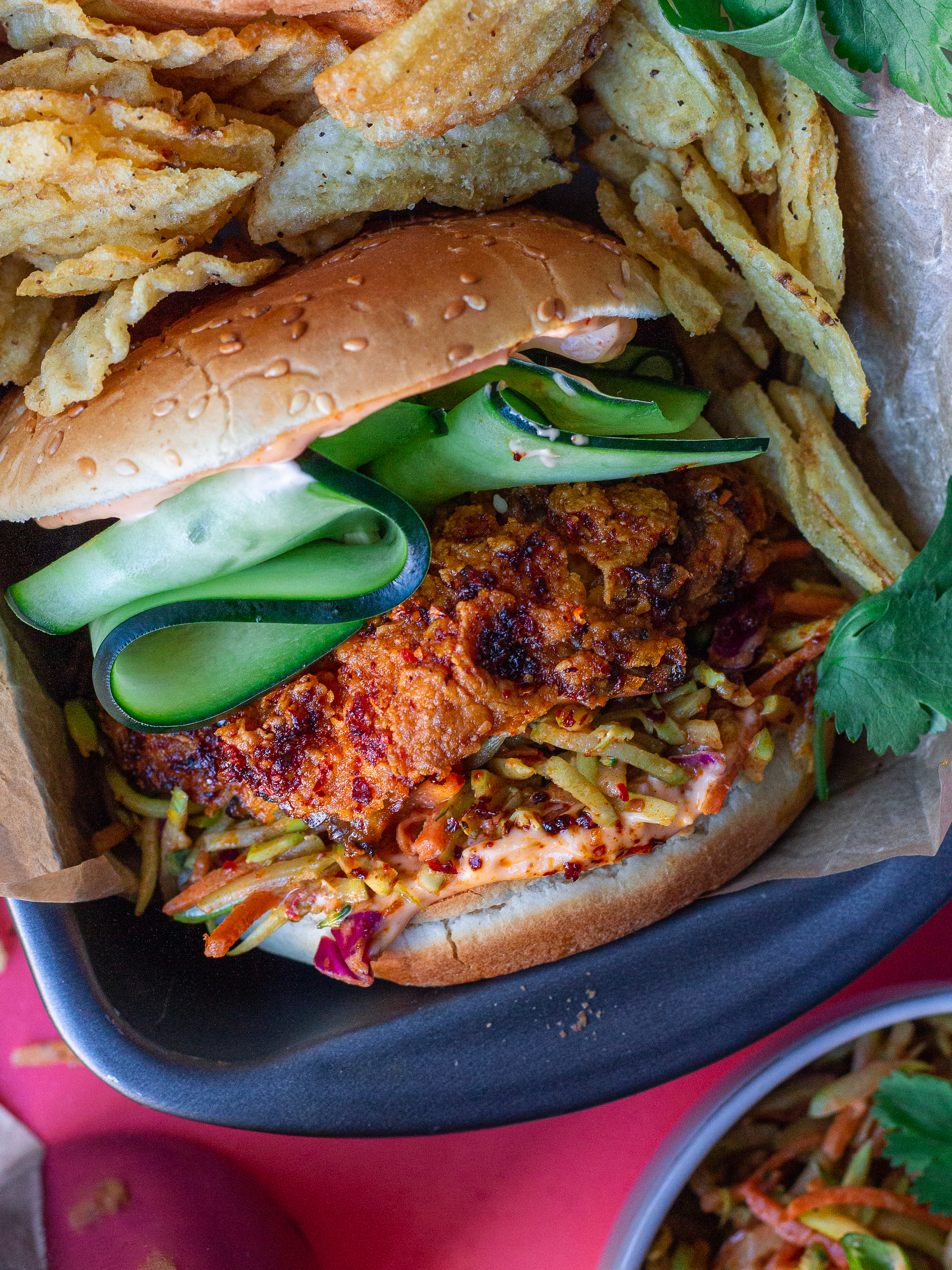
Korean-Style Hot Chick'n Sandwich
Ingredients
Gochujang Slaw:
- • 2 tablespoons gochujang
- • 2 tablespoons vegan mayonnaise
- • 2 tablespoons coconut sugar
- • 1 tablespoon low-sodium soy sauce
- • 1 tablespoon rice wine vinegar
- • 1 12-ounce bag broccoli slaw mix
- • 3 green onions stems removed and roughly chopped
Korean-Style Hot Chick’n:
- • 1 cup unsweetened and unflavored non-dairy milk
- • 2 prepared vegan eggs
- • 1 tablespoon rice vinegar
- • 1 ½ cups flour
- • 1 teaspoon salt
- • 1 teaspoon fresh ground black pepper
- • Vegetable oil for frying
- • 4 Maitake AKA Hen of the Woods mushrooms, stems removed and cut in half
- • ¼ cup gochugaru flakes
- • 1 tablespoon maple syrup
- • 1 teaspoon salt
- • 1 teaspoon garlic powder
- • 1 teaspoon ground ginger
- • ½ teaspoon cayenne pepper optional
- • ½ teaspoon white pepper
For the Sandwiches:
- • 4 split buns toasted
- • Gochujang mayonnaise optional (recipe below)
- • Gochujang slaw recipe above
- • Korean-style Hot Chick’n recipe above
- • Thinly sliced cucumber optional
- • Toasted sesame seeds optional
Gochujang Mayonnaise (optional):
- • 3 tablespoons gochujang
- • 3 tablespoons vegan mayonnaise
Instructions
- Instructions:
- In a small bowl, whisk together the gochujang, vegan mayo, coconut sugar, soy sauce, and rice wine vinegar. Place the broccoli slaw and green onion in a large bowl and pour the gochujang sauce over the slaw. Mix thoroughly until the slaw is fully coated in sauce. Cover and place in the refrigerator.
- For the dredging station, whisk the milk, vegan eggs, and rice vinegar in a container with a lid. In a separate container with a lid, whisk together the flour, salt, and pepper.
- Before you start coating your mushrooms, heat 2 ½ -inches of the vegetable oil in a deep sauté pan over medium-high heat.
- Meanwhile, transfer the mushrooms to the container with the wet mixture. Cover the container and gently shake, ensuring all pieces are evenly coated, then tap off the excess liquid. Add the wet mushroom pieces into the container with the flour mixture, cover, and gently shake, ensuring the mushrooms are fully coated in flour. Tap off any excess flour, then add them back into the wet mixture, cover and shake gently, then again into the flour, this time keeping any excess or clumpy bits stuck to the mushrooms. Transfer the coated mushrooms to a wire cooling rack and repeat until all the pieces are coated.
- Whisk together the gochugaru flakes, maple syrup, salt, garlic powder, ground ginger, cayenne, and white pepper in a heat resistant bowl and set aside.
- Once the oil is hot—you’ll know it’s ready when you sprinkle a bit of flour into the oil and it starts to sizzle immediately—fry the mushrooms in batches, until golden brown and crispy, 6 to 8 minutes. Transfer back to the cooling rack and repeat until all the mushrooms are fried.
- While the oil is still hot, use a ladle to transfer 1 cup of the hot oil to the heat resistant bowl. Stir to mix well and let the oil cool. Using a pastry or basting brush, brush the fried mushroom pieces with a generous amount of the chili oil. Alternatively, you can dip the pieces into the oil using tongs.
- If making gochujang mayonnaise, simply whisk together the gochujang and mayonnaise until combine.
- To assemble the sandwiches, spread a layer of gochujang mayonnaise on the bottom half of the bun, followed by a few spoonfuls of the broccoli slaw. Place a piece of chick’n right on top of the slaw, then some cucumber and toasted sesame seeds. Top the sandwiches with the top bun and enjoy with an extra side of slaw, your favorite potato chips or fries, and an ice-cold brew!
Notes


